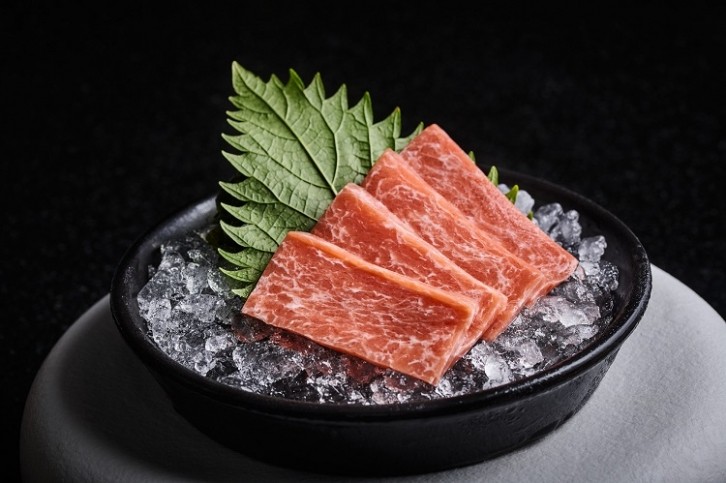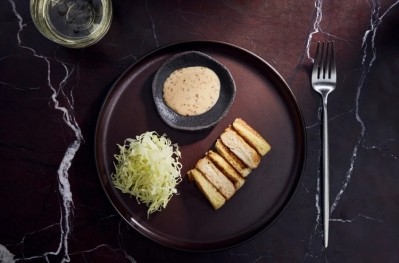How 'buttery' cultivated bluefin tuna is made, and served raw

Demand for bluefin tuna outweighs supply, making it an attractive proposition for cultivated seafood producers.
In Israel, Wanda Fish has its eye on the species, having developed a cultivated bluefin tuna toro sashimi prototype it claims achieves the same marbling as the real thing.
Why is Wanda Fish making bluefin tuna from stem cells?
Bluefin tuna is predominantly wild caught, rather than farmed. Although it comes with a hefty price tag, consumers don't appear to be put off; some are willing to pay well over $100 (€92) per kg for the fatty fish.
Attracted by such high prices, fishermen are working hard to boost supply – often without care for depleting fish stocks. According to the World Wildlife Fund (WWF), overfishing and illegal practices are responsible for ‘severely’ declined bluefin tuna populations in recent years.
In a bid to make bluefin tuna production more sustainable, Wanda Fish has developed a cultivated bluefin tuna toro sashimi prototype it hopes will achieve cost parity with its conventional counterpart sooner rather than later.
Wanda Fish: a brief history
Wanda Fish was founded in 2021 and has since attracted $10m (€9.2m) in investment.
Employees include co-founder and CEO Daphna Heffetz, VP of R&D Malkiel Cohen, and VP of business development Yaron Sfadyah.
The start-up has also worked closely cellular agriculture expert David Kaplan, an academic at Tufts University in Boston.
Last year, Wanda Fish closed a seed round of $7.1m led by AquaSpark. Round participants included Strauss Group’s The Kitchen Hub, Peregrine Ventures, PICO Venture Partners, MoreVC, and CPT Capital Ventures.
Wanda Fish makes bluefin tuna toro in a single bioreactor
Bluefin tuna toro sashimi refers to the ‘buttery’ underbelly of the fish. The underbelly contains not just the highest fat content, but is especially rich in omega-3s. Being tender and tasty, it’s perfect for use in sashimi dishes.
Wanda Fish claims its cell cultivated version champions the same sensory features of wild-caught toro sashimi and nutritional ‘richness’ – notably in terms of protein and omega-3 fatty acids.
A ‘pre-muscle’ stem cell known as myoblast cells are used in its production. “Our cell lines are immortalised, differentiate efficiently into muscle fibres, and accumulate selected fat using non-GMO techniques,” Wanda Fish co-founder and CEO Daphna Heffets told FoodNavigator.
It is this patent-pending fat formulation technology to which the start-up attributes much of its prototype’s success. The start-up claims to have achieved the same level of marbling in its product as the real thing, to give the product the look and mouthfeel of bluefin toro sashimi.
“We have developed a proprietary technology that enables us to induce, very efficiently and selectively, fat accumulation using our tuna myoblast cells to mimic the intramuscular fat of the toro bluefin tuna,” Heffets explained.
“This enables us to grow and differentiate the cells in one, single bioreactor – making the process economic.”
Wanda Fish’s downstream process: a deep dive
Wanda Fish considers itself lucky to have succeeded where most have failed. Growing bluefin tuna cell lines is ‘challenging’, with ‘very few’ companies succeeding, according to the CEO.
The start-up differentiates itself from competitors in three key ways: firstly in growing, immortalising and differentiating its bluefin tuna cell lines; secondly in its mimicking of the intramuscular fat of the toro bluefin tuna; and thirdly via its downstream manufacturing processes, which it describes as scalable and cost-effective.
Once the tuna cell biomass – including muscle, fat, and connective tissue – is grown in the bioreactor, Wanda Fish mixes it with a plant-based matrix to form a whole cut sashimi product. At a later stage, the start-up will use the same biomass to develop a whole-cut fillet.
“We developed an easy-to-scale and cost-effective downstream technology to create our sashimi and fillet that are produced and served raw, similar to wild-caught tuna.”
That means no cooking or panfrying of the product is required to serve up the final product.
“Using multiple bluefin tuna cells to create both muscle and fat, and our plant-based 3D design, we capture the essence of a raw fish fillet without preservatives, artificial additives, or GMOs,” said Wanda Fish VP of R&D Malkiel Cohen.
Cultivated bluefin tuna commercialisation strategy
Having a ‘strong business case’ is key to Wanda Fish’s strategy. Launching in late 2021, the start-up feels it’s in the fortunate position of being able to learn from sector pioneers.
Wanda Fish is keen to explore B2B and B2B2C strategies and intends to first launch its product in premium seafood restaurants and foodservice outlets, where bluefin tuna is mostly consumed. “Cultivated bluefin tuna and premium seafood restaurants make a lot of sense,” believes Heffets.

As to the start-up’s target markets, regulation understandably plays a key role in its decision-making. Cultivated meat and seafood is considered a novel food, meaning in many geographies it requires pre-market approval prior to commercialisation.
But regulation is not the only factor influencing Wanda Fish’s launch strategy. “Our first target markets are those having the combination of readiness of the potential consumers, regulatory pathways, and government willingness.”
The start-up currently sees a confluence of those factors in Israel, the US, and Asia. Within Asia, countries such as Japan, Korea and Singapore are considered the most promising from both a product and openness to new food perspective, we were told.
“Israel, Singapore and the US already have regulatory processes in place for cell cultured food,” Heffets added.
“We hear that Korea and Japan are working towards setting their regulatory frameworks, so we need to monitor these developments as we decide which country has a better path forward.”
How Wanda Fish plans to scale
Wanda Fish has begun testing several upstream technologies it hopes will optimise the scale-up process. At the same time, its R&D team is continuing to improve the taste, texture and appearance of the prototype, working towards tasting events in the medium-term.
“We are also discussing collaboration opportunities with potential technology and commercial partners,” the CEO revealed.

Later this year, Wanda Fish will kickstart a Series A funding round with the aim of furthering its scale-up in both upstream and downstream manufacturing processes, using both in-house and outsourced facilities. The start-up is keen on keeping CAPEX requirements low, meaning it will look to partner with contract manufacturing development organisations (CDMOs) - rather than manufacturer in-house at large-scale - down the line.
“The funds will also enable us to broaden our marketing and business development activities.”























